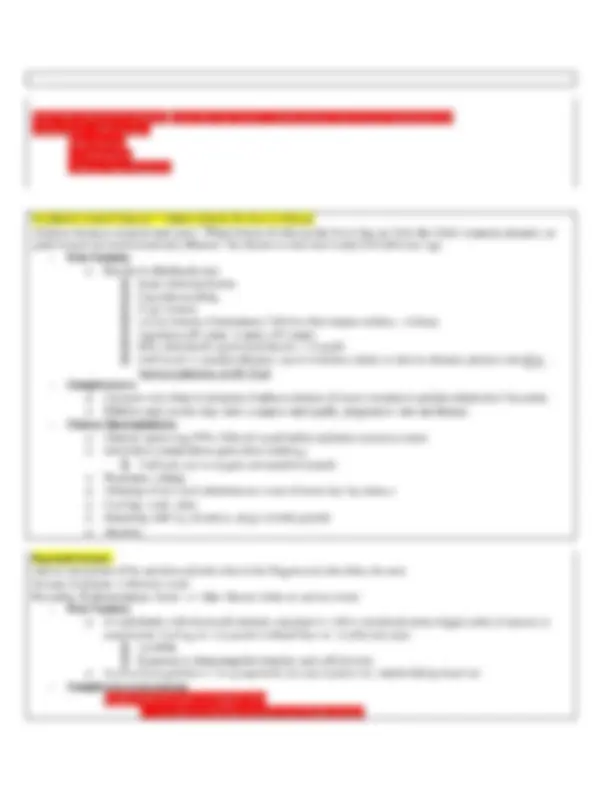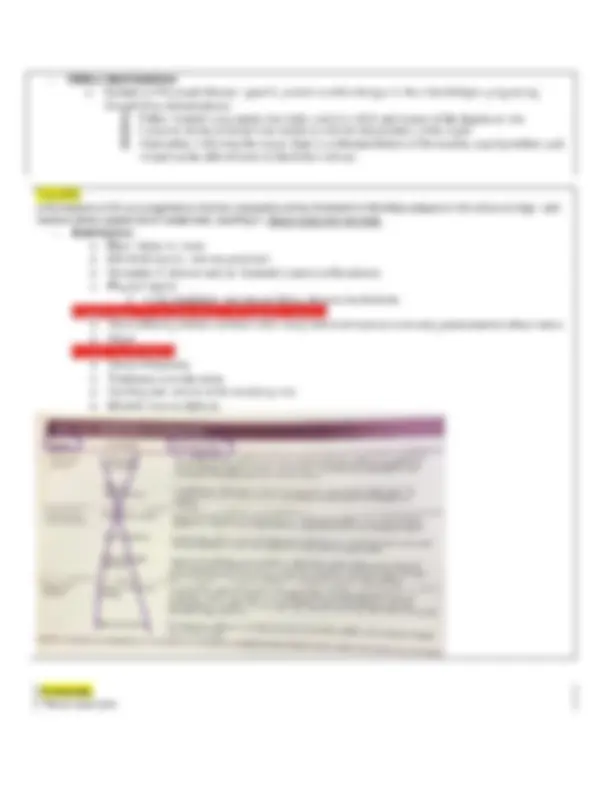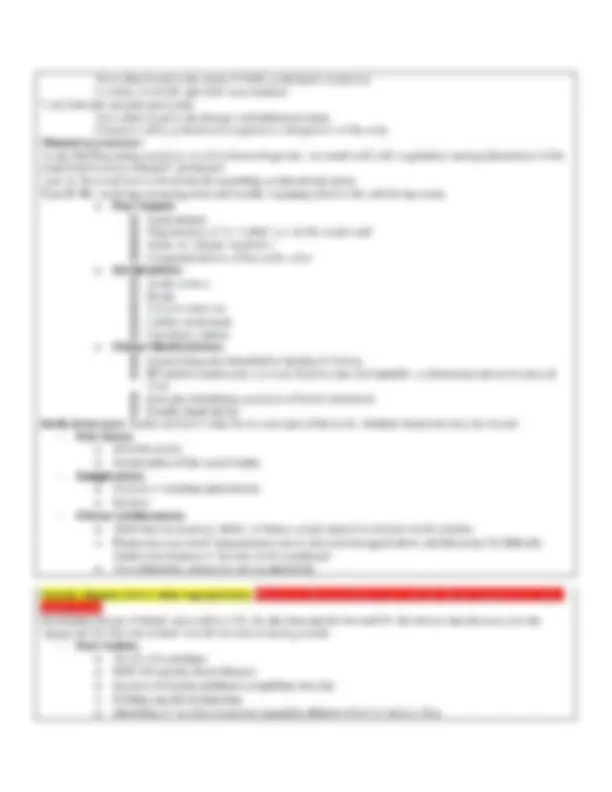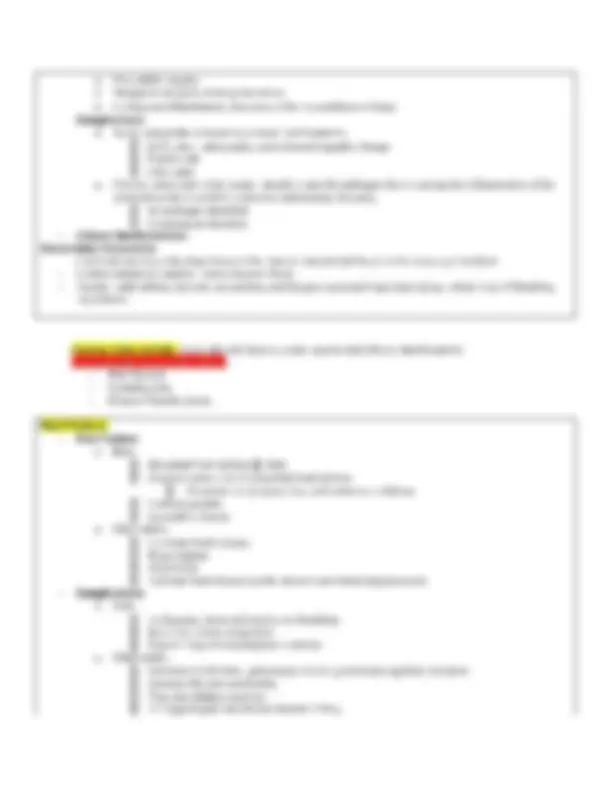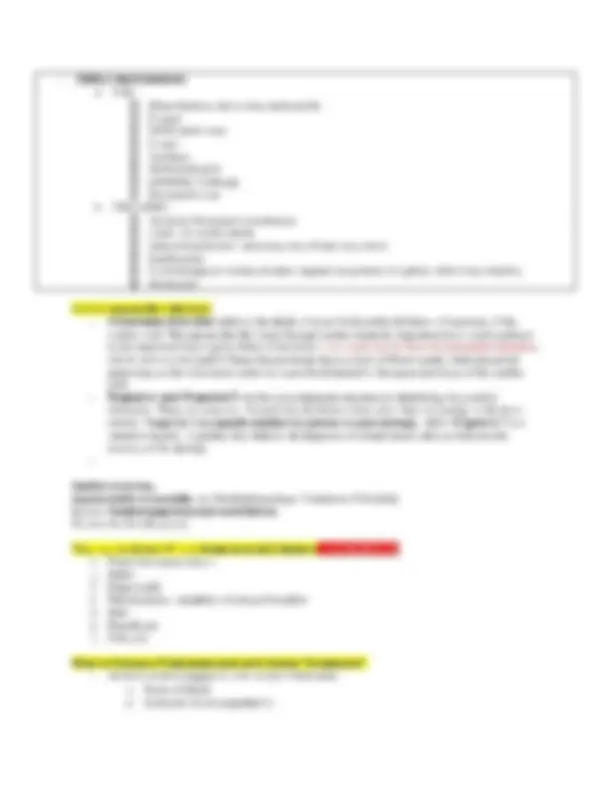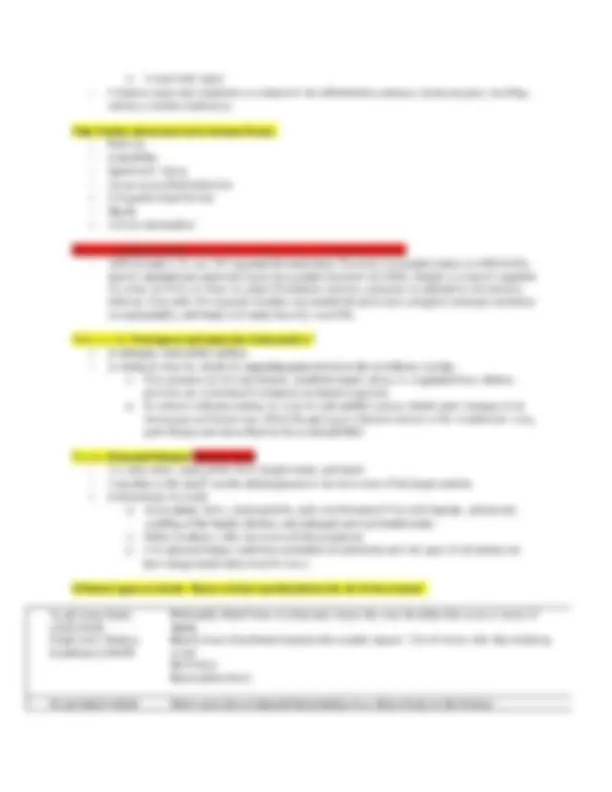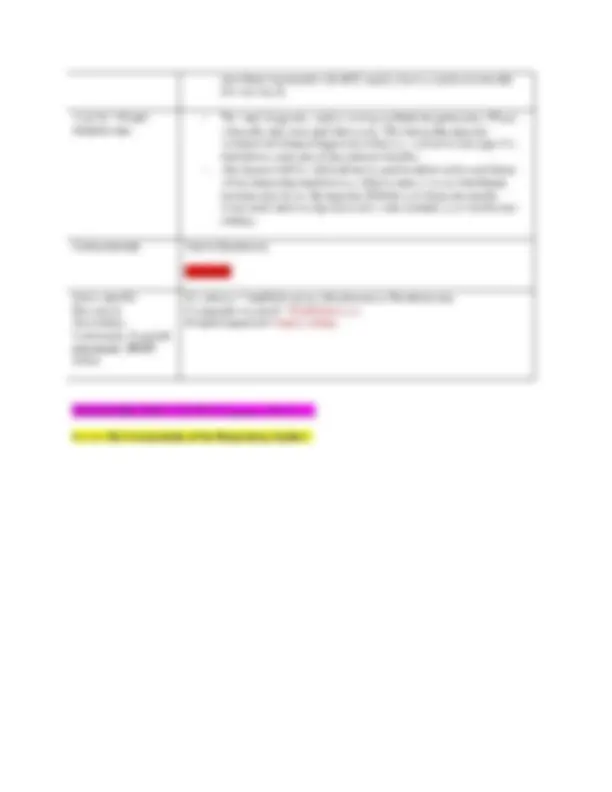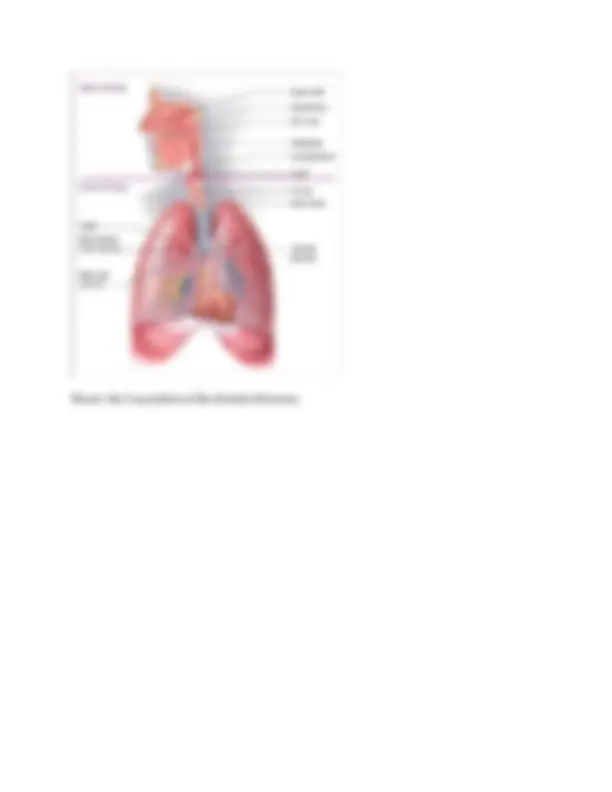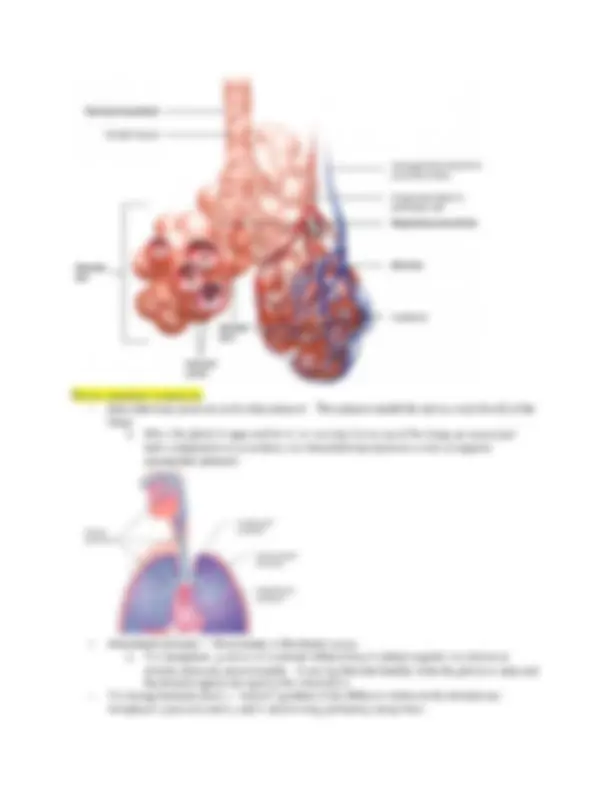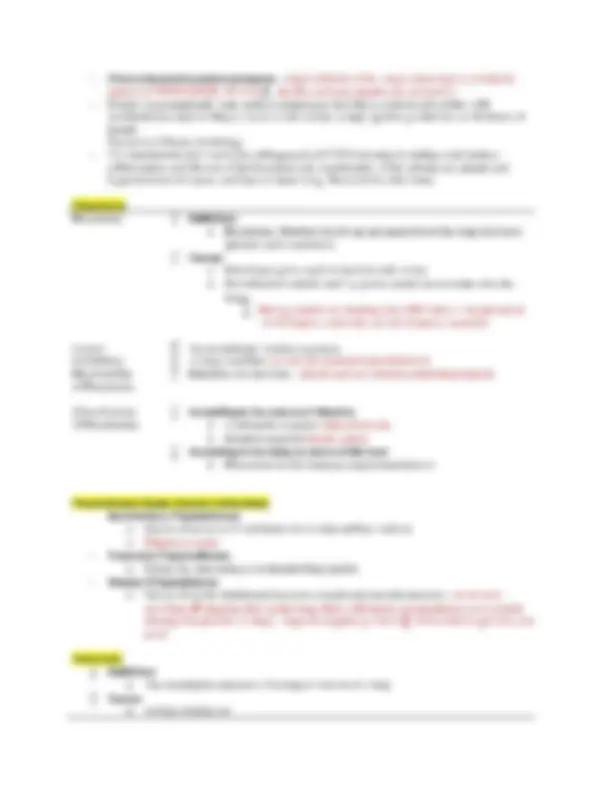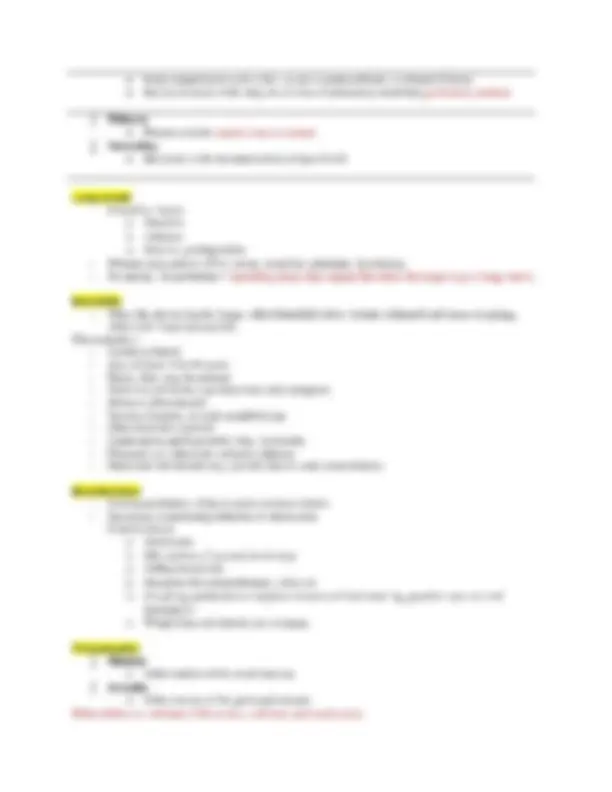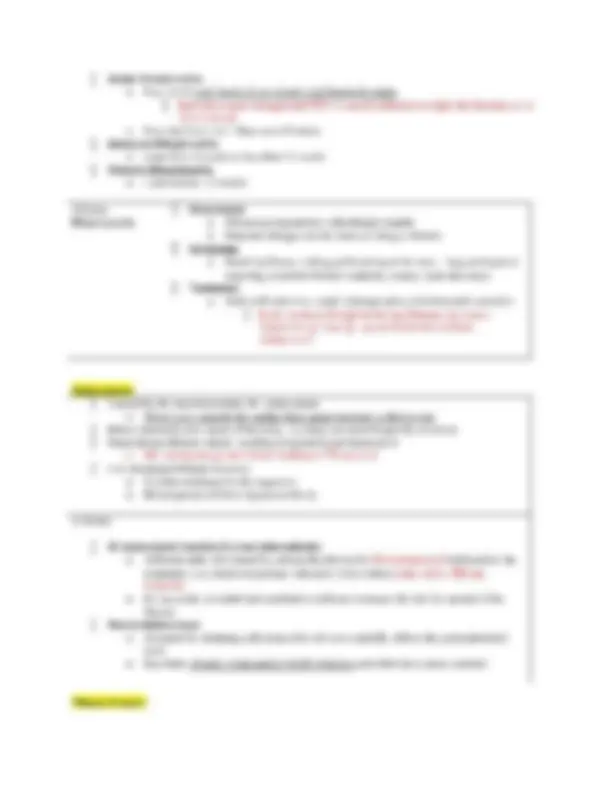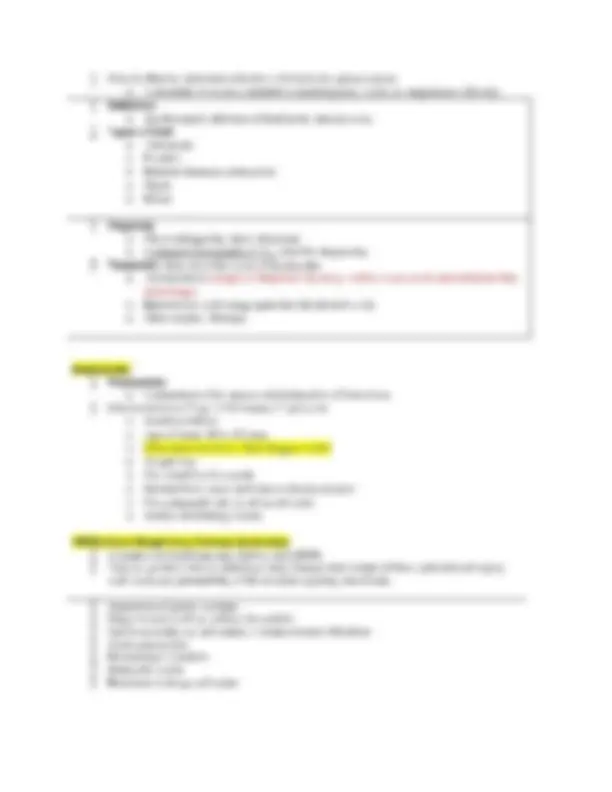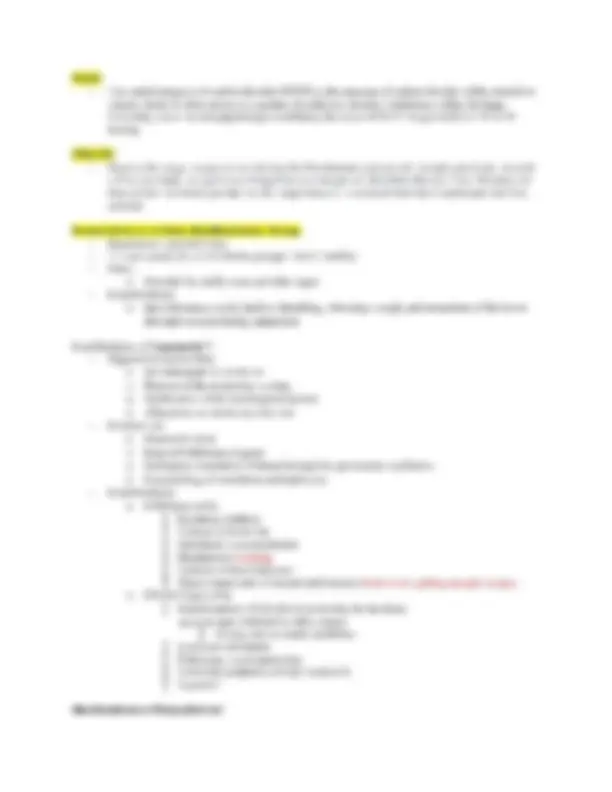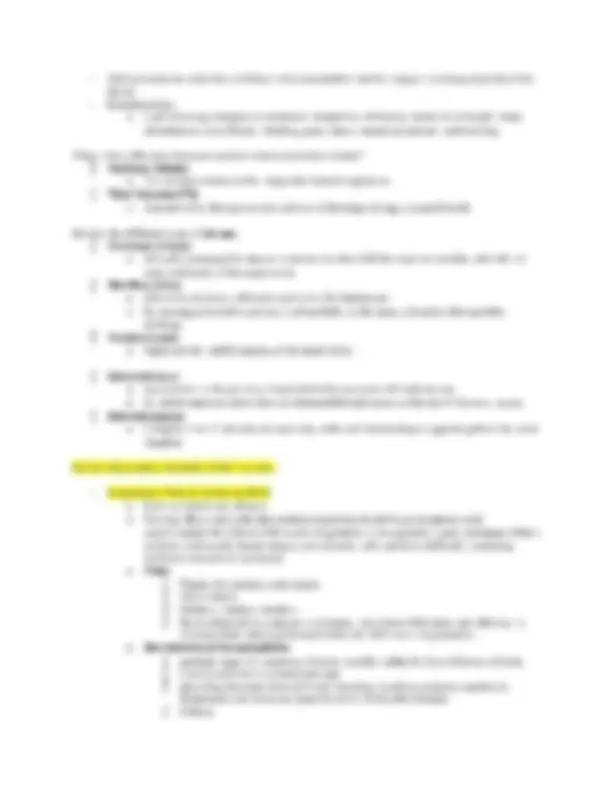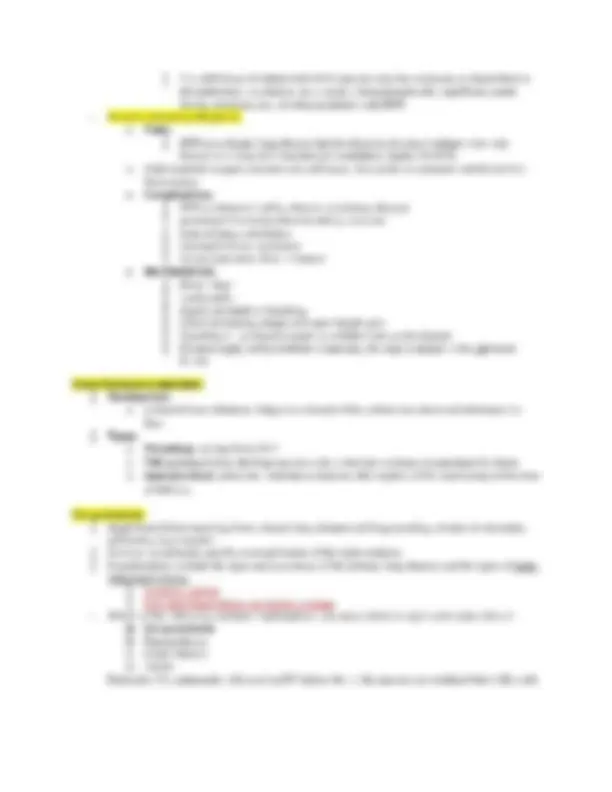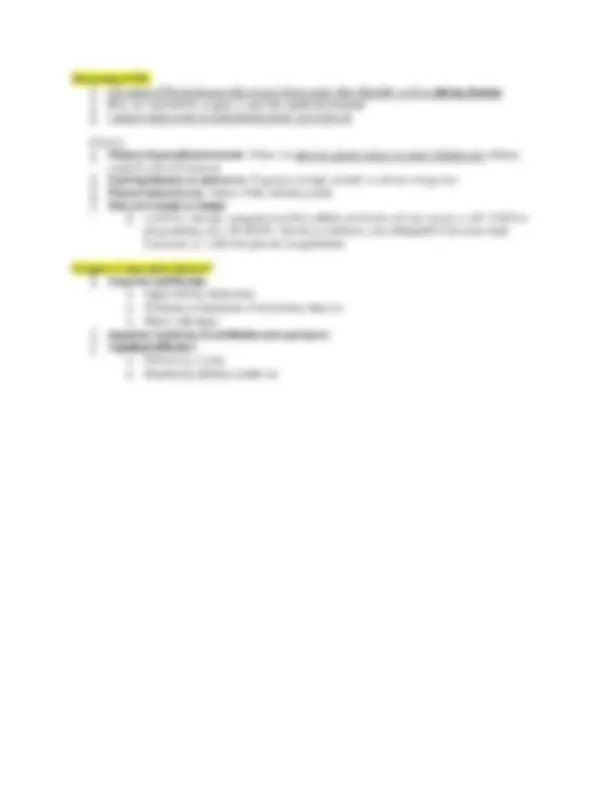Download CARDIOVASCULAR PATHO EXAM 3 and more Exams Nursing in PDF only on Docsity!
Review - Pericardium: providingthe Functional physical Forms Anatomy protectiona fibrous of thecoveringand Hearta barrier around(pericardium, to infectionthe heart myocardiumholding it in (^) aand fixed endocardium). position and o Epicardium that lines (^) Pericardialthe = (^) fibrousVisceral cavitypericardium layer is (^) a= spaceThin coversb/w that heart has andserous folds fluid, over b/w to formouter theand parietalinner =layer
- Myocardium: o Tropomyosin Muscular^ minimizes + portion;Troponin^ friction formscomplex the wall(Troponin of the atriaT, I, (^) C)and (2]ventricles regulate calcium mediated
- Endocardium: o Endothelial^ straited Three-layermuscle^ contraction. lining heart (inner2) outer):
- One-way^ o^ o^ DenseIrregularly valves^ elastic^ arranged^ fibers^ connective^ tissue^ (contains^ blood^ vessels^ and^ branches.
- Fibrous^ o^ Atrioventricular^ flow.skeleton^ valves^ and^ semilunar^ valves^ are^ pressure^ valves^ that^ ensure^ one-way o Provides structural support and isolating force for electrical impulse Review - Cardiaccardiac o Strokeoutput:output, volume:Amountpreload ofthevs bloodafterload,amount pumped of Baroreceptorsblood each pumped minute withand(SV Chemoreceptors.each(stroke beat volume) x HR (heart rate))
- Preload^ o o^ vsPreload:Heart Afterload^ rate: Ventricular^ the^ number filling,^ of^ timesend diastolicthe^ heart pressurebeats^ each^ minute o o Afterload: bloodNotes: into Resistanceaorta to ejection of blood from heart, post contraction required to move
- Baroreceptors: cardiovascular o Function: (^) centersPressure alter inHR, receptorsthe strengthbrain respondingstem of cardiacto to contraction,changes in arterialand vascular pressure smooth BY impulsesmuscle to the
o Notes: Monitor Stretch sensitiveblood pressure receptors
- Chemoreceptors: Regulate o Ex:ventilation. BP drops,Arterial Chemor. chemoreceptors, Stimulated monitorby low O2blood and levelshigh CO2of oxygen, and Hydrogen CO2, hydrogen build up.ions.
o Notes: Oxygenation Carbon dioxide
What - are (^) Edema:the causes swelling of edema?^ pH caused by too much fluid trapped in body tissues o Imbalance compartment of anyand ofthe thetissue factors spaces that control movement of water between the vascular
o Disproportionate colloidal osmotic increasepressure, inor capillaryimpaired fluidlymph pressure flow or permeability, decreased capillary What - - are (^) ControlsControlthe functions ofthe platelet transfer of theadhesion ofEndothelial molecules and blood Cells?across clotting the vascular wall
- ModulationMetabolismRegulation ofofof immunebloodhormones flowand andinflammatory vascular resistance reactions
- Influence o Endothelial that the occurgrowth in (^) dysfunctionresponseof other cellto describesenvironmentaltypes potentially stimuli reversible changes in endothelial function
o Products Cytokines,that )] causeHemodynamic bacteria,inflammation viruses stresses
[) Lipid^ o products(Transition^ Orthostatic^ fromhypotension:^ supine^ toWhen^ standing)^ BP^ dropsOrthostatic^ when^ standing,Hypotension:^ elderly
)] Hypoxia^ o^ (Fats^ and^ oils,^ phospholipids^ and^ Steroids)
Atherosclerosis Progressive - Risk diseasefactors: characterized by formation of fibrofatty plaques in the intima of large- and medium-sized vessels. o Hypercholesterolemia Cigarette Hypertension smoking Family Age HDL (mencholesterol history >45 years;of (goodpremature women cholesterol) CHD>55 years) in (^) <40a first-degree mg/dL relative - siblings CRP infection, Homocysteine levels: 8-10: C-reactive levelsViral Protein; due to infection, injury or chronic disease: greater than 50 = bacteria
- Complications: Ischemic Stroke heart disease Peripheral Clinical Narrowing manifestations vascularof the vessel disease ofand atherosclerosis resulting ischemia o Vessel^ ThrombosisAneurysm^ obstruction formationand^ formation^ due^ to^ plaqueof^ emboli^ hemorrhage^ or^ rupture
- Clinical o Typically,manifestations: In (^) largernot evident vessels, for the (^20) importantyrs. Or longer. complications Depends onare thethose vessels of thrombus involved! formation and weakening of In Arteries^ the medium-sizedvessel supplying^ wall. arteries, the heart, ischemia brain, (^) kidneys,and infarction lower dueextremities, to vessel andocclusion small intestineare more arecommon. most frequently involved.
O^ 00O^
O0OO0O 0o O^ 00O^
O0OO0OO0OO
- Clinical o Episodes throughManifestations threeof Raynaud's distinct phases:disease typically present as color changes in the affected digits, progressing Pallor: Cyanosis: Hyperemia: Arterial Reduced Following vasoconstriction blood the flowspasm, resultsleads there to in (^) ispalea abluish reboundor whitediscoloration dilationappearance of ofthe (^) the ofarteries, thedigits. fingers causing or toes.redness and warmth in the affected area as blood flow returns. Vasculitis
- Risk (^) o o Factors:Direct injury to o o Physical agents Clinical^ o o^ OnsetOnsetManifestations of headache o o o TendernessSwelling and over redness the arteryof the overlying skin TABLE 26-2. Classification Examples of the Vasculitides
Inflammation medium-sized ofvessels the is ablood progressive vessel wall,disease resulting characterized in tissue injuryby formation and necrosis. of fibrofatty plaques in the intima of large- and Infectious Secondary agents,to disease^ vessel immune such (^) as:processes Systemic Lupus Erythematosus Complications o Onset affecting(taken^ Cold, from irradiation,arteries Giant and^ Cellmechanical then Temporal entire^ injury, (^) arteryArteritis)^ immunewall with^ mechanisms focal necrosis and granulomatous inflammation. Blurred vison or diplopia vessels, involvement^ Characteristics^ Necrotizing including^ vasculitisof the capillaries, pulmonary^ with^ few venules, (^) capillariesor^ no andimmune arearterioles; (^) commondeposits necrotizing^ affecting glomerulonephritismedium^ and^ small^ bloodand Medium-sized vessel^ Small^ vasculitis vasculitisvessel^ Polyf&teritis^ graQulgmatosisMicroscopfc (^) nodosa^ affecting^ common^ Granglomatqus^ capillaries,^ inflammation^ venules,^ arterioles,involving^ andthe^ arteries;respiratory^ necrotizing^ tract^ and^ glomerulonephritisnecrotizing^ vasculitis^ is Kafwasaki rombodngiitis disease gftger:}::tal,.thxjonlnlbos}ilng,.nerves I;lzglves^ Neq;']()tlgmg^ capillaries, 1th mucocutaneous » principally large,^ or^ inflammation^ venules; medium-sized, the the^ lymphusually tibial ;cn;te^ of node^ medium-sized and and^ associated and radial syndrome; smallchronic arteriesarteries^ with^ or inflammation usually^ small^ underlying (^) but (frequently someti^ arteries occurs metimes^ disease of the in^ without the small extending coronaries) medium-sized^ or^ environmental children^ vasculitis i (^) toand the^ in and is veins^ arteries, associatedi small^ agents Large vasculitis vessel Arteritisiant^ literans (^) cell (tefgporal)^ of^ the^ extremities;^ occurs^ almost^ exclusively^ in^ men^ who^ are^ heavgy^ smokers^ S Takayasu arteriti^ with Granulomatous^ g(rti::::lorr}altous^ o^ (^ polymyalgia^ I:anlna^ uclear^ vesile^ cells;^ inflammat'^ ullflammationrheumatic^ s^ usually.occurs^ of^ the^ carotid 10n o^ of ft^ the heao^ artery;^ in^ people^ aorta It^ aandlsbinfiltration^ and^ older it:^ its^ than^ major ranche^ of^50 vesselbranches^ years S5 Q usually^ wall^ of^ with^ with^ age^ $ occurs^ and^ predilection^ giant^ gl^ is i 1n^ cells peOple^ oft^ a^ e^ N^ fo^ dr younger Aneurysm, *Berry aneurysm
*Fusiform andMost^ Consists saccular^ often^ of^ foundaaneurysms^ small,^ in^ sphericalthe^ circle^ vesselof^ Willis^ dilation^ in^ the^ brain^ circulation *Dissecting Most^ Characterizedaneurysm^ often^ found^ by^ gradualin^ the^ thoracic^ and^ progressive^ and^ abdominal^ enlargement^ aorta^ of^ the^ aorta Acute, vessel Type A:walllife-threatening Proximal to form lesionsa blood-filled condition. involving Involveschannel the ascending hemorrhage a d descendinginto the vessel aorta. wall with longitudinal tearing (dissection) of the Type B: Not (^) o involvingRisk Factors:ascending Hypertension aorta and usually beginning distal to the subclavian aortra Degeneration Assoc. Congenital w/ Marfandefects of the Syndrome (^) ofmedial the aortic layer valve of the vessel wall o Complications: Aortic Stroke rupture Visceral Cardiac Circulatory tamponadeischemia failure. o Clinical (^) Excruciating BPManifestations: initial is moderatelypain described elevated, as tearing then (^) becomeor ripping. unobtainable, as dissections interrupts arterial
Syncope, Possible^ flow. hearthemiplegia, failure paralysis of lower extremities
Aortic - Aneurysm:Risk (^) o factorsAtherosclerosis Aortic aneurysms may involve any part of the aorta. Multiple aneurysms may be present
- Complications^ o o^ DegenerationErosion of vertebrae^ of^ the^ vessel(abdominal)^ media
- Clinical^ o o^ RuptureTheremanifestations may be dyspnea, stridor, or brassy cough caused by pressure on the trachea. o o Hoarseness swallowingMost abdominal maybecause resultaneurysms of frompressure arepressure asymptomaticon the on esophagusthe recurrent laryngeal nerve, and there may be difficulty Valvular Incomplete disease closure (mitralof mitral valve valve regurgitation), with LV SV divided\ZaiG betweenRN GCRIER the (^) forwardR G AN SVS thatAL (^) movesN BT TRinto the RO (^) aorta[ R aatande v (^) theRVEIAYE regurgitant - Risk SV (^) o Factors:thatMitral moves valve back prolapse into the left atrium during systole RHD Rupture Papillary (Rheumatic ofmuscle chordae dysfunctionHeart tendineae disease) or papillary muscles O^0 0o Stretching of the valve structures caused by dilation of LV or valve orifice.
o [IF atherosclerosis Promotes Predisposes plaque coronary formation heart disease,and rupture heart failure, stroke, and PAD o Secondary: Dyspnea Peripheral and edema fatigue Ascites Signs of fluidright buildheart upfailure in abdomen, (cor pulmonale) “third spacing” PIH (^) - (pregnancy Risk (^) o Factors: (^) Preeclampsiainduced hypertension), syndrome
- Complications^ o o^ UnderlyingDecreased placentalchronic^ hypertensionblood flow, disrupts fetal growth and preterm delivery o o HELLPP-E (^) Hypoperfusion(Hemolysis, elevated of vital liver organs enzymes, and low platelet count)
disseminated Cerebral Hepatic failurehemorrhage intravascular coagulation
- Clinical o ElevatedManifestations AcuteHP:^ renal^ failure
o Stage 1 HP^ S;^ D:^ 120-129<
o Stage 2 HP^ S;^ D:80-89^ 130- o Preclampsia-eclampsia^ S;^ D:^ >140>
Stage Thrombocytopenia Renal 2 insuffiencies HP <100,
Elevated Pulmonary Disturbance creatine edemaof vision levels
Pericarditis. An inflammatory - Risk Factors: process of the pericardium , Can be acute, chronic, or constrictive o o o ViralBacterial/Connective infections mycobacterial tissue more diseases common infections (systemic cause lupusof acute erythematosus, rheumatoid arthritis) o Uremia
o o o PostcardiacNeoplasticContiguous invasionsurgeryinflammatory of the processespericardium of the myocardium or lungs
- Complications o Acute pericarditis ECG, chest is (^) radiography,based on clinical and echocardiographymanifestations. change
o Chronic Friction^ Chestpericarditis^ pain^ rub (they cannot identify a specific pathogen that is causing the inflammation of the
- Clinical pericardiumManifestations:^ No^ Autoimmune^ pathogenbut^ it^ could^ identifieddisorders^ be^ related^ to^ autoimmune^ disorder) Constrictive - - CalcifiedCardiac Pericarditis outputscar tissueand cardiacdevelops reserve between become the visceralfixed. and parietal layers of the serous pericardium.
- Ascites, respiration) pedal edema, dyspnea on exertion, and fatigue, Kussmaul sign (near dying, certain way of breathing — Cardiac - RiskValve Factors: leaflets. Know the risk factors, complications and clinical manifestations
- ComplicationsClinical Manifestations Heart - Failure.Risk (^) o Factors:Kids:
Structural Surgical [) Alterations correctionheart defects ofin congenitalpressure,7] kids low,heart and defects resistance relations
o Older adults:^ Cardiomyapathy^ Kawaski’s^ disease
Coronary Hypertension Arrythmias heart disease
- Complications o Kids:^ Valvular^ heart^ disease^ (aortic^ stenosis^ and^ mitral^ regurgitation) Tachypnea, Systemic Rapid filling venous increasedof noncompliantcongestion respiratory ventricle breathing o Older adults: Increases Increase HRin leftand atrial,contractility pulmonary venous, pulmonary capillary pressures Vascular LV hypertrophy stiffness andincrease altered diastolic filling
- (^) andCommon odeep^ Vessel (^) musclesigns^ walland tenderness. symptomsinjury are related to the inflammatory process, including pain, swelling, Risk (^) - - FactorsBedImmobility restAssociated with Venous Stasis.
- (^) AcuteCongestiveSpinal myocardialcord heartinjury failureinfarction
- (^) VenousShock obstruction
Review - theACS and elevation DeterminantsST-segmentincludes on ECGUA, elevation areofnon—ST-segment thethose ACS (Q-wave)in (Acutewhom elevationmyocardialthromboticCoronary (non—Q-wave) Syndromes)infarctioncoronary occlusion(STEMI). Status.myocardial isPeople subtotal infarction without or intermittent, (NSTEMI),ST-segment
What are^ whereas^ on theangiography, Predisposing^ those^ with^ and^ ST-segmentFactorsmany^ ultimatelyfor^ Endocarditiselevation^ have^ areQ-^ usually?wave^ MI.found^ to^ have^ complete^ coronary^ occlusion
- AA damagedportal o Theof (^) entryendocardialpresence by which of surfacevalvular the organism disease, gainsprosthetic access heartto the valves, circulatory or congenital system heart defects o providesIn innocuous persons^ an withoralenvironment lesionpreexisting may^ conducive (^) affordvalvular the^ toorpathogenic^ bacterialendocardial^ growth.bacteria defects, access simple to (^) thegum bloodstream.massage or an(any Review Kawasaki^ gum disease^ disease _^ can^ cause^ them^ to^ have^ endocarditis)
- TheVasculitisImmunologic skin, brain,in thein eyes,originsmall joints,vessels liver, and lymphprogresses nodes, to (^) involveand heart some of the larger arteries o o Acute swellingSubacute phase: ofphase: thefever, handsdefervescence conjunctivitis, and feet, andand rash,enlargeddesquamation involvement cervical (^) lymphof the oralnodes mucosa, redness and o Convalescent have disappeared phase: after complete about 8§ resolutionweeks of symptoms until all signs of inflammation Acute DifferentLung Injury^ types of^ shockPotentially^ -^ Know^ clinicallethal form^ manifestations of pulmonary^ forinjury^ all^ of thatthe mayshocks™* be either the cause or result of (ALI)/Acute Respiratory Syndrome (ARDS) (^) Distress Rapidshockevent onset of profound dyspnea that usually occurs 12 to 48 hours after the initiating Definition Intervention focus Acute Renal Failure Most cases due to impaired renal perfusion or direct injury to the kidneys
Gastrointestinal DegreeLoss of^ isappetite,^ related nausea,to^ severity vomiting^ or^ duration^ of^ shock Complications (^) Development IschemiaSuperficial mucosal of sepsis lesions and shockof the stomach and duodenum Disseminated Intravascular Coagulation (DIC) WidespreadandSystemic thrombotic formation activation occlusion of ofthrombin theof smallcoagulation and midsized system vesselswith resultant formation of fibrin clots Multiple Dysfunction Syndrome Organ(MODS) RapidlyAffectsOminous multipledepletescomplication organthe body’s systems—Iungs,of shock ability to compensate kidneys, liver,and recoverbrain, heartfrom a shock state Risk bowel, factors: advanced sepsis, age, prolonged severe trauma, periods alcohol of hypotension, abuse hepatic dysfunction, infarcted Treatment to Reverse Correct Shock (^) andMeasures FluidRestoreImprove resuscitation bloodoxygen flow delivery Review the Phases of HemodynamicCardiac Potentials^ stability
- (^) PhasePhasePhase 0:2:1: rapidearlyplateau repolarizationupstroke of the action potential
- PhasePhase 3:4: finaldiastolic repolarization repolarization period period Electrocardiography - - TwelveDiagnostic leads ECG
- (^) ImproperEachDiagnostic providing leadcriteria placementa unique are lead viewcan specific. significantlyof the electrical change forces the ofQRS the morphology.heart Disorders^ -^ Misdiagnosisof Atrioventricular^ of^ cardiac Conduction^ arrhythmias (1st^ orand^ the 3rdpresence degree^ ofAV^ conduction block)^ defects^ can^ be^ missed.
- First (^) o o degreeProducesIschemia regularor infarction atrial and ventricular rhytmn o o o RheumaticMyocarditisGoes away, feverdoes not require a pacemaker
- Third o o degree:AtrialDecrease Completeand inventricular cardiac AV (^) outputblock depolarization with periods being of (^) syncopecontrolled (fainting) by separate = Stokes pacemakers. Adams Attack Know the Cardiac^ o^ Requires Conduction^ pacemakers System.
have skin testbeen result. vaccinated with BCG usually have a positive tuberculin Tests Reliable for onesTB and - (^) tuberculin measuresThe most frequentlytheskin delayed tests andusedhypersensitivity chestscreening x-ray. methods The(i.e., tuberculin cell-mediated,for pulmonary skin testtype TB IV)are
- that TBThe byfollowsQuantiFERON-TB measuring^ exposure interferon-y,^ to Goldthe^ tubercle testwhich is usedbacillus.is partto detectof the activecell-mediated and latent immune turnaround, settings. activity but itto is TBexpensive response.20 and isIt nothas availablea 24-hour at testall resultshealth care Corticosteroids Anti-Inflammatory Know Bacteria Pericarditis, specific in PericarditisCommunity-acquiredHospital-acquired = Staphylococcus, = Staphy= Staphylococcus aureus Streptococcus, Pneumococcus Community-Acquired pneumonia, (HAI) HOSP.
Review the Components of the Respiratory System.
Upper airways (^) ‘ (^) - : (^) / NasalNasopharynxOral (^) cavity cavity | \l\ (^) )T (^) - 3 g— a—{ OropharynxLaryngopharynx Lower_____________________________________________ airways \ Trachea ApexLaynx of _____.lung CarinaN Right lobar (^) bronchussuperior (^) ———————==%&% (^45) il YR N2 4 --—;———%—R ’:« - Leftbronchus main Right bronchus main f
Review the Composition of the Alveolar Structures.
- The and against isintrathoracic thea closedpressure glottis, pressureto which such = thepressureas occurslungs, inheart, (^) duringthe thoracic anddefecation great cavity. vessels and It theisare equal (^) Valsalvaexposed. to the (^) maneuver, (^) Forcedintrapleural expiration produces pressure Conducting^ marked airways,^ increases^ in^ intrathoracic^ pressure^ and^ impedes^ venous^ return^ to^ the^ right^ atrium.
- (^) LarynxTracheobronchialNasopharynx and oropharynxtree
- Function: o Move air out of the lungs but does not participate in gas exchange Types - ofAnatomic dead o spaceThat Dead contained Space in the conducting airways
- AlveolarPhysiologic o ThatDead Deadcontained Space Space in the respiratory portion of the lung Control of breathing.^ o^ The^ anatomic^ dead^ space^ plus^ alveolar^ dead^ space
- Respiratory o Pacemaker center Pneumotaxic center center o Phrenic ApneusticNerve^ center
- Automatic o Controlled Regulation Chemoreceptors: by inputOf Ventilationfrom twomonitor types bloodof sensors levels or (^) ofreceptors: oxygen, carbon dioxide and adjust Lung^ ventilation receptors:^ to^ meet monitor^ the^ changing breathing^ metabolic patterns^ needsand lungof^ the function^ body
- Voluntary o o IntegratesThese Regulation acts, breathinginitiated of Ventilation withby the voluntary motor andacts premotor such as cortex,speaking, cause blowing, a temporary and singing suspension of What happens during^ automatic inspiration^ breathing. vs expiration?
- Inspiration which air is isexpelled the process from bythe which lung air is brought into the lungs. Expiration is the process by What is (^) Viralthe difference (^) o infectionRhinoviruses, betweenof the upper (^) parainfluenzacommon respiratory cold viruses, andtract influenza? respiratory Mode syncytial of Transmission virus, corona !viruses, and
Fingers Cough, sneeze^ adenovirusesare the greatest source of spread. Always handwashing to prevent transmission
o The entry nasalof the mucosa virus. and conjunctival surface of the eyes are the most common portals of
- CommonFlu = Respiratory cold = Airbornedroplets, Droplets,cough or coughedsneeze or sneezed into the air Asthma Factors^ Review: Allergens the Development^ Contributing toof^ RespiratoryExercise^ tract^ infections
an Asthmatic B G G^ E^ E^
S Drugs and chemicals
Attack HormonalAirborne Gastroesophageal pollutantschanges refluxand^ emotional^ upsets
Factors Involved Pathophysiology in the Genetico Atopy Early versus late phase
of Asthma Environmental o o VirusesAllergens Classifications Mild o^ intermittentOccupational — Comes^ exposure and goes
of Severity Asthma Mildrun Moderate - persistent 20 yearspersistent or— moreso — havingconstant, symptoms it does more damage to airways in the long
Severe persistent
Cystic Fibrosis Cystic fibrosis Definitiono An autosomal recessive disorder involving fluid secretion in the
Cause^ exocrine^ gastrointestinal,^ glands^ andand^ thereproductive^ epithelial^ tractslining^ of^ the^ respiratory,
o Mutations encodes which functions for in thea single cysticas a chloridegenefibrosis on (C17)thetransmembrane long channel arm ofin chromosomeregulatorepithelial (CFTR),cell 7 that Manifestations Fibrosis of Cystic PancreaticPancreatitisElevation ofexocrine sodium deficiencychloride in the sweat
Nasal^ Excessive Sinus polypsinfections^ loss^ of^ sodium^ in^ the^ sweat
Cholelithiasis
COPD - The obstructive term chronic airway obstructivediseases. Whichpulmonary disease disease processes (COPD) have canbeen be identifieda combination as being of twopart types of COPD of
o o LungIncreased compression recoil of suchthe lungas thatdue occursto loss inof pneumothoraxpulmonary surfactant or pleural pulmonary effusion surfaces
Primary Secondary o Present at birth smacks them to scream
o Develops in the neonatal period or later in life Lung - cancerCausative o Smoking factors
- Primary^ o^ o^ AsbestosFamiliallung tumors^ predisposition (95%) versus bronchial, glandular, lymphoma Bronchitis^ -^ Secondary^ via^ metastasis^ =^ Spreading^ from^ other^ organs^ that^ affect^ the^ lungs^ to^ give^ lung^ cancer Characteristics:^ - -^ When^ oftenSmoking^ withthe historyairwaysmucus^ production.in^ the^ lungs,^ called^ bronchial^ tubes,^ become^ inflamed^ and^ cause^ coughing,
- AgeBarrelShortness of chestonset of maybreath, 30 tobe (^40) present (^) a yearspredominant early symptom
- RhonchiOftenSputum dramatic frequent,often presentcyanosis an early manifestation
- HypercapniaFrequentNumerous corlife-threatening andpulmonale hypoxemia and episodes polycythemiamay be duepresent. to acute exacerbations Bronchiectasis - - PermanentSecondary (^) todilation persisting of the infection bronchi orand obstruction bronchioles
- Manifestations o Atelectasis Obstruction of the smaller airways Diffuse Recurrent Coughing; bronchitis bronchopulmonaryproduction of copious infection amounts of foul-smelling, purulent sputum; and o O^0 hemoptysisWeight loss and anemia are common.
0o
Rhinosinusitis Rhinitis o Inflammation of the nasal mucosa
Rhinosinitius^ Sinusitis o^ is Inflammationa mixture of thoseof^ the two,^ paranasal both nose^ sinuses and nasal cavity
Acute o rhinosinusitisMay be Bacteriaof viral, bacterial,is more stronger or mixed and viral—bacterial YES we need originantibiotics to fight the bacteria, even
Subacute^ o^ May rhinosinusitis^ last^ if^ fromit^ is^ mixed^5 to^7 days^ up^ to^4 weeks
Chronic^ o o^ LastsLastsrhinosinusitis^ frombeyond^4 weeks 12 weeks^ to^ less^ than^12 weeks
Allergic Rhinosinusitis Occurrenceo o MucosalOccurs in changesconjunction are thewith same allergic as allergic rhinitis rhinitis.
Symptoms o Nasal sneezing, stuffiness, recurrent itching frontal and headache, burning ofwatery the nose,nasal frequentdischarge bouts of
Treatment o Oral antihistamines, Body produces nasal histamine decongestants, during allergies,and intranasal too much cromolyn
histamine histamines!! spill out [?] use antihistamine to block
Tuberculosis Caused o byOuter the waxymycobacterium, capsule that M. makesTuberculosis them more resistant to destruction
Infect Macrophage-directed o practicallyNot strong any enough organattack, sometimesofresulting the body, inleading theparenchymal lungs to TBare survivalmostdestruction frequently involved Cell-mediated o o (^) DevelopmentConfers immune resistance ofresponse tissue to the hypersensitivity organism FORMS: M. tuberculosis hominis (human tuberculosis) o Airborne respiratory transmit) infection secretions spread of personsby minute with dropletactive nucleituberculosis (like pneumonia)(only active harboredTB can in the Bovine^ o^ tuberculosisLiving^ disease^ under^ crowded^ and^ confined^ conditions^ increases^ the^ risk^ for^ spread^ of^ the o o Acquired tractHas been byvirtually drinking eradicated milk from in Northinfected America cows; initiallyand other affects developed the gastrointestinalcountries Pleural effusion

